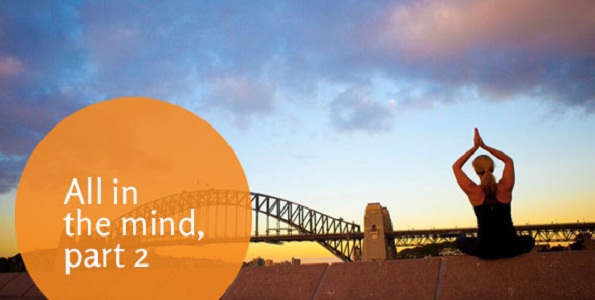All in the mind (part 2)
In my last blog, I talked about mindfulness and meditation. To recap: both practices aim to focus and clear our minds and help us become calm, efficient and orderly. We can practice informally, through day-to-day mindfulness, and/or formally, through sessions devoted to meditation.
In this blog I’m going to tell you what I’ve learned about how to go about each practice.
First, a warning. Mindfulness doesn’t happen overnight. But, as they say, it will happen. Benefits start appearing within a couple of weeks. It’s exactly like training; you can’t run a marathon immediately but if you run every day, you’ll start seeing progress quite soon. The important phrase here, the one you need to remember, is ‘every day’. Constant practice is the key.
Let’s begin with everyday mindfulness practice. The object is to distance yourself from your mind-chatter, to take your mental temperature, to know how to say ‘stop’ anytime – even in a crisis situation – and by remaining in the moment, make better decisions and avoid doing or saying things you’ll regret. You can practice mindfulness anywhere and any time and once you get the hang of it, you’ll automatically be more mindful in any situation.
You need to
- Pay close attention to your breathing, especially when you’re feeling intense emotions.
- Notice – really notice – what you’re sensing in a given moment, the sights, sounds and smells you don’t usually consciously register.
- Don’t judge. Recognise that your thoughts and emotions are fleeting and don’t define you. This insight can free you from negative thought patterns. Tune into your body’s physical sensations, from the water hitting the skin in the shower to the way your body rests in an office chair. (These points are taken from the Greater Good Science Center, at the University of California, Berkeley)
Here’s how it might work. Imagine you’re washing dishes, thinking about a fight you had at work today, or worrying about a bill you need to pay tomorrow. Tell your mind to stop. Concentrate on the physical. Feel your breath, noticing how it moves through your body. Centre yourself, feeling the warmth of the water and the movement of your hands on the dishes. Notice how your body is standing, where you’ve tightened your muscles because of stress. In a few minutes you’ll feel more relaxed, your mind clearer.
Obviously, this description just skims the surface and you’ll find a lot more information on the web, including exercises you can do to help you become more mindful (for examples, see the Greater Good site, above).
Now about the formal practice of meditation. There are hundreds of courses and books on meditation and hundreds of ways to meditate. Here’s just one simple, classic, example:
- Like mindfulness, to get benefits you need to practise every day. You can start with 3 – 5 minutes and build up as you go.
- Find a time and place where you won’t be disturbed. Decide how long you’re going to meditate, and have a clock in view.
- Sit comfortably (no, you don’t have to sit cross-legged, a chair is fine). Something that keeps your spine straight is best. Closing your eyes helps.
- Let yourself relax. Check your body to see if you’re holding muscular tension, and let it go.
- Let go of any concerns in your mind.
- Bring your mental attention to your breath. Take a few long, slow, deep breaths then let the breath settle into its own pattern. Breathe slowly and easily, in and out through the nose. Let the breath flow naturally rather than forcing it.
- Bring your attention to the physical point where the breath enters and leaves your body, usually just behind the nose. Just observe the sensation as the breath goes in and out.
- Your mind will wander. Just notice this. Don’t worry about it, don’t judge it. Let the thoughts go by like in a parade. Don’t get involved in them, just keep returning to your breath.
- When the time is up bring your attention back to your body and how it feels. Slowly get up and stretch gently.
- Try to maintain that relaxed state of mind for as long as you can.
And that’s all there is to it. Simple? Um, no…actually it’s quite hard. Our monkey minds are so used to bouncing around that it takes time, time, time to even start to bring them into line.
But it does happen and one of my new year’s resolutions is to start my own daily mindfulness journey. And try to practice it when it counts, like really listening to my kids instead of doing three other things at the same time. Life’s too short to not pay attention!
And that brings me – mindfully – wishing you and your family a wonderful and happy festive season and an equally fantastic 2016. It’s hard to believe how quickly this year’s flown by. Let’s join minds, and hearts, and wish for a future filled with happiness and harmony.
What’s going on
How gamification helps workplace training: games are part of our lives now – just ask anyone with a smartphone. Here’s why we should apply them to workplace training programs.
Why you shouldn’t feel guilty about working out during work: David Linden, a professor of neuroscience, claims 30 minutes of aerobic exercise a day is the best thing you can do for your brain. What does that say about exercise and work, and how can exercising during the working day help your brain?
What is innovation, and should we care about it? Yes, we should. At Springday, I’m always going on about innovation’s importance to business, and our PM, Malcolm Turnbull, thinks it’s so critical to Australia he’s allocating $1 billion to nurture it. This article, from The Conversation, tells us more.
..and talking about innovation, what is disruptive innovation? Disruption is when a smaller company with fewer resources successfully challenges established businesses, and ‘disruptive innovation’ (also called ‘disruptive technology’), currently attracts a great deal of academic and commercial attention. This piece, from the Harvard Business Review, explains disruption innovation theory, tells us how it developed, why it matters and why it’s important to business.
An economics essay you might just enjoy: want to learn about comparative advantage, task allocation, and trade? This clever essay will teach you, and surprise and delight you as well.
The cloud wars explained: the market for cloud computing is increasing exponentially. Why? Who are the players and why is Amazon leading the pack?
31 science-backed ways to avoid holiday weight gain: look, I had to include a link to at least one article about eating over Christmas, so here it is. At least this one has science on its side. Bon appétit!
Tech tips
If you play a sport, you probably worry about your form. How’s your running stride? Could you improve your golf swing? What about tennis – is your serve up to scratch?
You could hire a coach, but who’s got the money for that, never mind the time? Well, as usual, apps to the rescue. The New York Times recently had a look at apps which run the gamut from offering videos of ‘correct’ form, to assessing your personal form and suggesting improvements. They might not be quite as good as a flesh-and-blood coach, but they’re worth checking out. Here’s a link.
And another thing
The last word on meditation: remember I said meditation wasn’t easy? Here’s a video on the ten stages of trying to meditate for the first time. Hysterical, but true.
Adele performs Hello with classroom instruments: here at Springday, we’re huge fans. Here she is with Jimmy Fallon and the Roots, performing her most famous song with classroom instruments.
And finally, relax with a movie over the break: here are the 30 ‘don’t miss’ movies predicted to win Oscars next year. Not all of them have made it down under yet but you might like to get acquainted with those that have, and do your Oscar homework at the same time.










